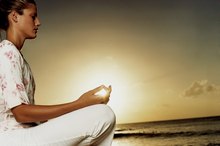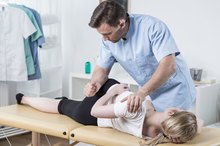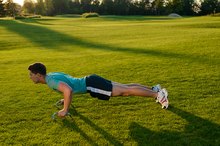What does fact checked mean?
At Healthfully, we strive to deliver objective content that is accurate and up-to-date. Our team periodically reviews articles in order to ensure content quality. The sources cited below consist of evidence from peer-reviewed journals, prominent medical organizations, academic associations, and government data.
The information contained on this site is for informational purposes only, and should not be used as a substitute for the advice of a professional health care provider. Please check with the appropriate physician regarding health questions and concerns. Although we strive to deliver accurate and up-to-date information, no guarantee to that effect is made.
Hiatal Hernia & Yoga Poses
Dr. Julio Kuperman, a Philadelphia based neurologist, and Dr. Jeff Migdow, a holistic practitioner in Lenox, Massachusetts, are two yogis who believe that yoga can alleviate the pain and discomfort caused by hernias. Their experience is described in a Yoga Journal article. Dr. Kuperman, who has been practicing yoga for 25 years, and teaching yoga for 10, cured his own hernia through his practice. He and Dr. Migdow prescribe gentle poses for the treatment of hernias.
Significance
A hiatal hernia occurs when part of the stomach pushes into the diaphragm. According to the Mayo Clinic, hiatal hernias usually cause few physical problems and often go unnoticed unless detected by medical tests or procedures used when evaluating an unrelated health condition 2. In those rare instances where break-through of the stomach wall is severe enough to create untreatable heartburn or other painful trauma, surgery is usually prescribed. If practicing yoga can help you to avoid surgery, it may be worth investigating.
- A hiatal hernia occurs when part of the stomach pushes into the diaphragm.
- According to the Mayo Clinic, hiatal hernias usually cause few physical problems and often go unnoticed unless detected by medical tests or procedures used when evaluating an unrelated health condition 2.
Theories/Speculation
How to Heal a Pinched Nerve with Yoga
Learn More
Yoga poses of benefit to people diagnosed with a hiatal hernia are those utilizing the third chakra 1. Yoga theory centers around the seven chakras, swirling vortexes which run from the human tail bone along the spine to the crown of the head. Every yoga pose uses one of the seven chakras as an energy center. The chakras are portholes where energy is absorbed, received, distributed, and donated. When a chakra becomes blocked or flooded, physical or emotional injury occurs. The third chakra is centered over the stomach, says yogajournal.com.
- Yoga poses of benefit to people diagnosed with a hiatal hernia are those utilizing the third chakra 1.
- Yoga theory centers around the seven chakras, swirling vortexes which run from the human tail bone along the spine to the crown of the head.
Types
In his book, "Yoga-The Path to Holistic Health," B.K.S 4. Iyengar illustrates 27 poses for treating hiatal hernias. Iyengar is an internationally acclaimed guru who has been teaching yoga for 70 years. He uses blankets, bolsters, blocks, belts, and chairs as props for beginners and people who are less flexible. Kundalini,Vinyasa, Ashtanga, Power, and Bikram yoga are four more branches in the myriad yoga forms that have sprung up. Ashtanga and Power yoga are more vigorous and Bikram Yoga is done in a hot room.
- In his book, "Yoga-The Path to Holistic Health," B.K.S 4.
- Kundalini,Vinyasa, Ashtanga, Power, and Bikram yoga are four more branches in the myriad yoga forms that have sprung up.
Warning
Deep Breathing Meditation Technique
Learn More
Poses that put pressure on the abdomen, such as Cobra, Bow, and Bridge Pose should be avoided. Inversions, such as Shoulder-stand and Headstand, should also be excluded. Downward Dog Pose is a classic pose and an excellent spine stretch, but it places the diaphragm below the stomach and could allow acid from the stomach back into the esophagus, says yogajournal.com. All poses should be done with the approval of your doctor and under the supervision of a certified yoga instructor.
- Poses that put pressure on the abdomen, such as Cobra, Bow, and Bridge Pose should be avoided.
Benefits
Holding yoga poses for an extended number of breaths strengthens and stretches the muscles. Over time, the yoga student becomes aware of his breathing. Mindful breathing is a useful tool for everyday life. By breathing slowly and rhythmically, you relax the body and mind. Relaxed breathing allows the diaphragm to push up toward the heart and the stomach to drop toward the spine. In the words of Iyengar, "The mind is king of the senses. The breath is king of the mind."
- Holding yoga poses for an extended number of breaths strengthens and stretches the muscles.
- Relaxed breathing allows the diaphragm to push up toward the heart and the stomach to drop toward the spine.
Related Articles
References
- Being diagnosed with a hernia doesn't have to mean the end of your yoga practice. By YJ Staff
- Hiatal Hernia Definition by Mayo Clinic Staff
- A prescription of asanas to help balance the subtle energies of the chakra system. By Barbara Kaplan Herring
- Yoga The Path to Holistic Health; B.K.S.Iyengar; 2001
- How simple breath work can lead you to a deep state of relaxation. By Claudia Cummins
- Riley KE, Park CL. How does yoga reduce stress? A systematic review of mechanisms of change and guide to future inquiry. Health Psychol Rev. 2015;9(3):379-96. doi:10.1080/17437199.2014.981778
- Uebelacker LA, Broughton MK. Yoga for Depression and Anxiety: A Review of Published Research and Implications for Healthcare Providers. R I Med J (2013). 2016;99(3):20-2. doi:10.1176/appi.focus.16104
- Felver JC, Butzer B, Olson KJ, Smith IM, Khalsa SB. Yoga in public school improves adolescent mood and affect. Contemp Sch Psychol. 2015;19(3):184-192. doi:10.1007/s40688-014-0031-9
- Halpern J, Cohen M, Kennedy G, Reece J, Cahan C, Baharav A. Yoga for improving sleep quality and quality of life for older adults. Altern Ther Health Med. 2014;20(3):37-46.
- Shannahoff-Khalsa DS. An introduction to Kundalini yoga meditation techniques that are specific for the treatment of psychiatric disorders. J Altern Complement Med. 2004;10(1):91-101. doi: 10.1089/107555304322849011
- Telles S, Sharma SK, Balkrishna A. Blood pressure and heart rate variability during yoga-based alternate nostril breathing practice and breath awareness. Med Sci Monit Basic Res. 2014;20:184-93. doi: 10.12659/MSMBR.892063.
Resources
- Yoga The Path to Holistic Health by B.K.S. Iyengar
- How simple breath work can lead you to a deep state of relaxation. By Claudia Cummins
Writer Bio
Katherine Garner started writing for LIVESTRONG.COM in 2010. She was certified by the American Council of Exercise in personal training and aerobics in 2000, yoga and Pilates in 2001 and Zumba in 2010. Based at JW Marriott and Ihilani Spa since 2000, Garner holds a Bachelor of Science in geology with a minor in creative writing from Virginia Polytechnic Institute and State University.









